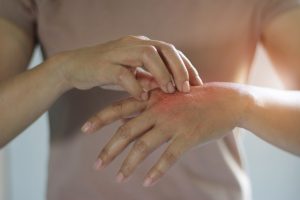
Published in the journal Scientific Reports, the study followed 1,800 families from around the world who had genetic skin disorders for five years. These families all had skin conditions such as epidermolysis bullosa (EB). This severe skin disease causes blisters and poorly healing wounds from the lightest touch.
A total of 360 EB patients were chosen to analyze DNA isolated from blood samples for sequence variants in a set of 21 genes known to harbor mutations that cause the skin disease. The analysis revealed that two patients had the exact same mutation in a gene known as JUP.
These two patients had shown symptoms in early infancy such as extremely fragile skin, thickened skin on the soles of the feet and palms of the hands, and hair loss that extended to eyelashes and eyebrows. One patient was a 22-year-old woman who had the skin disorder when she was young, and now has a heart condition called arrhythmogenic right ventricular cardiomyopathy (ARVC). The other patient was a 2.5-year-old boy who shows skin anomalies but no heart conditions.
The study was able to confirm that mutations in JUP that cause EB can also lead to stiffness of the heart muscle and ARVC. This means that although the boy did not yet show any signs of heart problems, the genetic findings from this study suggest that he will develop them down the road.
“This means that with mutation analysis, you can predict when looking at EB patients at birth, whether they will have this very severe heart condition later in life,” Dr. Uitto says. “These patients need to be monitored carefully for heart problems.”
In ARVC, the heart develops abnormal rhythms and becomes weak due to a ridged, fibrous tissue that displaces healthy heart muscle. ARVC patients are vulnerable to heart failure and sudden cardiac death and have been found to be responsible for as much as 20 percent of sudden cardiac deaths in those under 30. Many patients with this heart condition require an implantable defibrillator to manage life-threatening arrhythmias.
Genes Associated with Skin Conditions
This new study’s findings add to a string of discoveries that Dr. Uitto and his colleagues have unveiled in recent years in their search for the genes that underlie severe skin conditions. One of their more prominent studies in 2019 had analyzed patients with ichthyosis, an inherited skin disorder in which dead skin cells accumulate in thick, dry scales on the skin’s surface.
They found that patients with genes associated with the skin condition also developed liver problems later in life that were severe enough to require a transplant.
“We are looking to identify new genes behind skin diseases like EB and ichthyosis,” Dr. Uitto said. “By looking at patients’ symptoms and family history, we have uncovered something completely unexpected.”
These studies are able to show how the skin can help to predict severe medical problems. By looking at common genes and mutations, researchers hope to continue finding links between skin conditions and disease which may help reduce the risks of severe medical problems for people later in life.